From bucket-and-spade seaside spots to rugged and remote coastal coves, we’ve got your summer weekends covered.
1. Honne-Kamp
Hondeklipbaai, Northern Cape
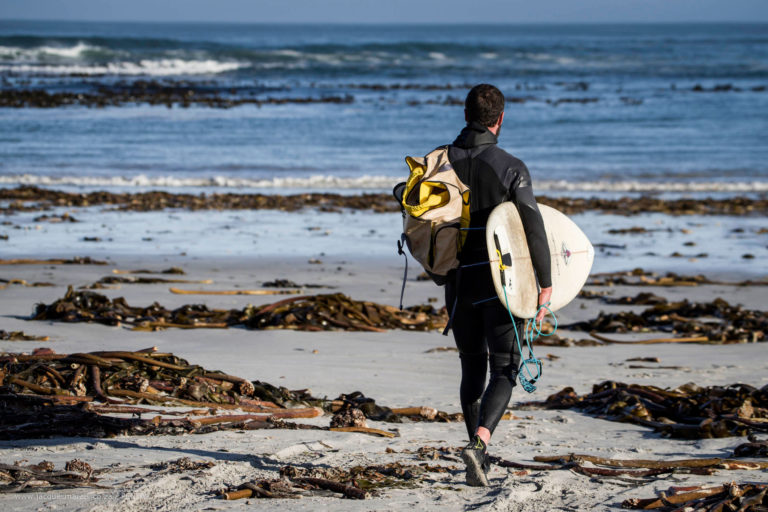
There’s a reef or beach-break option for surfers off the main Hondeklip beach.
Hondeklipbaai (Dog-Stone Bay) was named after a rocky outcrop that apparently resembles a dog – but probably only after a solid session of Klippies and Coke. Be that as it may, this West Coast hamlet brims with characters and attractions, and has, over time, achieved legendary status as one of the Northern Cape’s premier seaside holiday destinations. A rather topsy-turvy history has seen the town go through a number of booms and subsequent collapses – copper, crayfish and diamonds – before settling on tourism.
At first glance, Hondeklipbaai appears a bit haphazard, the beauty of its 14-kilometre beach not immediately tangible. The West Coast has a rough edge to it, so don’t come here expecting anything fancy. But there is a cappuccino machine at The Shack (the barista may be out on a crayfish mission)! Although the campsite is set back a street from the beach, it will take you less than a minute to get there. The water’s icy and tempestuous tides often dump seaweed on the sand, but the dunes and rock pools below the lighthouse are great for exploring.
Get the necessary permit, don your (very thick!) wetsuit and dive into the icy Atlantic for a crayfish or two (in season, of course). Or, if surfing’s your thing, a reef in the bay often throws up a solid right-hand break. To the south, Spitfire Rock spews up dramatic spray when waves thunder against the rocky shores, and it’s a great sundowner spot. – Jacques Marais
Do It Honne-Kamp has six sites, each with electricity, water, a picnic table, and braai facilities. The shared ablutions are clean and neat, and there’s an on-site swimming pool and playground. Sam’s Restaurant is a stumble away, as are a few small shops and a bottle store. From R380 for a four-person stand. 0833211600, honnepondokkies.co.za
2. Kwass se Baai
Namaqua Maqua National Park, Northern Cape
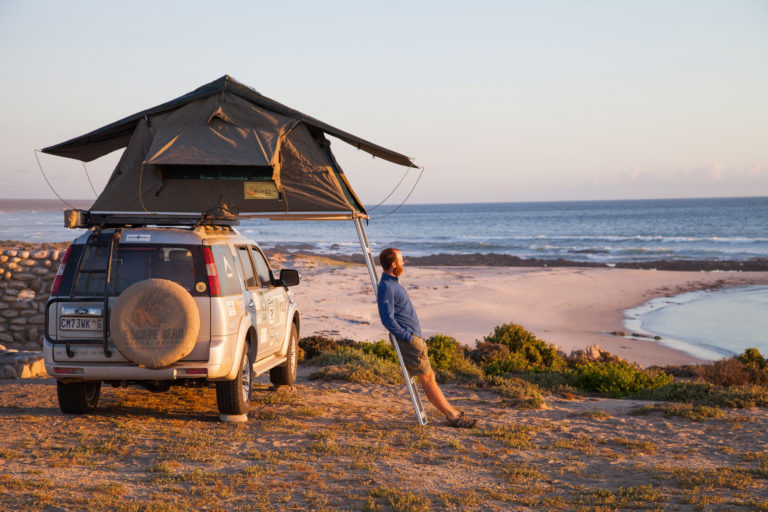
Wild camp spots near the town are relatively peaceful, but out of season the municipal campsite is largely deserted anyway. The sea, for diving, swimming and surfing, is less than 20 metres away from the ‘resort’.
Frost-fisted waves of Atlantic rollers pound a sun-drenched shoreline of strandveld that for most of the year looks a bit bedraggled, but bursts into colour during spring flower season. Hundreds of Cape fur seals weave through the rich kelp forests and come ashore to warm up on the rocks.
This virgin shore in the Namaqua National Park runs for around 50 kilometres and the four individual sites at Kwass se Baai have the best setting – on an elevated ridge overlooking a crescent beach, with great views of the sunset over the ocean. Simple stone walls provide protection from the prevailing southerly wind and a long-drop toilet is the only amenity. For old and young alike there is blissfully little to do here other than explore the veld and coastline (only on the designated tracks), skinny-dip in the icy ocean and warm up afterwards in the blazing sun or around the fire with a cup of steaming tea. – Scott Ramsay
Do It There are nine campsites on this stretch of protected coast spread out across 40 kilometres. From south to north they are: Groen Rivier (12 sites), Delwerskamp (seven), Kwass se Baai (four), Varswater (four), Bamboeskamp (four), Skuinsklip (two), Koringkorrel Baai (five), Skuinsbaai Noord (two), and Boulderbaai (six). Bring all your camping equipment, drinking water, food, and other supplies.
Tip Good for vygies in the Cape flower season. A 4×4 with diff lock and high ground clearance is a must, as there are stretches of thick sand. There’s a seal colony of several thousand animals between Skuinsbaai and Boulderbaai (17 kilometres north of Kwass se Baai). From R147 per six-person site. 0276721948, sanparks.org
3. Strandfontein Holiday Resort
West Coast
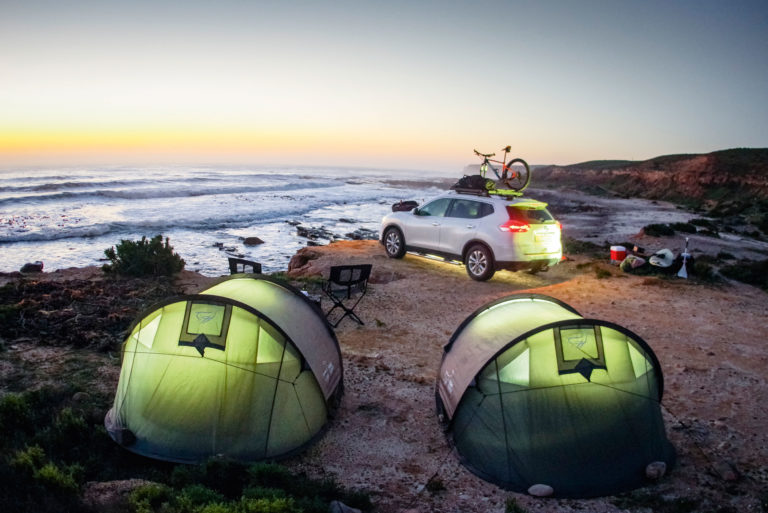
The camping-only resort forms part of the Kogel Bay Biosphere Reserve and there are three nature walks just over the road.
There’s only one problem with the Namaqua West Coast region – too much wine and way too little time to drink the stuff. Add to this the fact that Namaqua residents do not seem to have an off-switch, and you have either paradise or purgatory.
Strandfontein is a case in point. It’s a languid dorp for most of the year, but come summer it’s packed with sunseekers looking for a good time. Strandfontein Holiday Resort is the hub of this bakkie-and-beach party, with two sections of campsite grass unfolding right onto the main beach. Fortunately, out of season there’s usually not a soul in sight – cue me and my surfboard. And, yes, there’s wine. Just down the drag in Doringbaai, you’ll discover Fryer’s Cove Winery in a unique setting right on the old harbour pier.
If you can pry yourself away from the seafood and chenin blanc, explore the dramatic coastline between here and Strandfontein. For more remote camping, there are plenty of spots along the West Coast where you can ‘wild-camp’ right on the ocean’s edge, with only the swish of Atlantic rollers for company, and regular whale sightings and spring flowers from late July through September. Winters can get rather chilly, with fog and the occasional winter storm – but nothing a camp fire and bottle of local red can’t solve. – Jacques Marais
Do It The Strandfontein Holiday Resort (read caravan park) is laid out in four sections, but I would recommend either A Block or Perdeskoen Block. All sites have electricity and water: A Block’s 25 sea-front stands, sharing communal ablutions, cost R290 per stand. The 25 A Block sites against the back wall have private ablutions at R260 per stand. Perdeskoen is set further back and has 39 stands with private ablution facilities for R260 per stand. Each stand is limited to one vehicle and a maximum of six people. 027201 3437/3401, visitnwc.com
4. Kogel Bay Resort
Gordon’s Bay, Western Cape
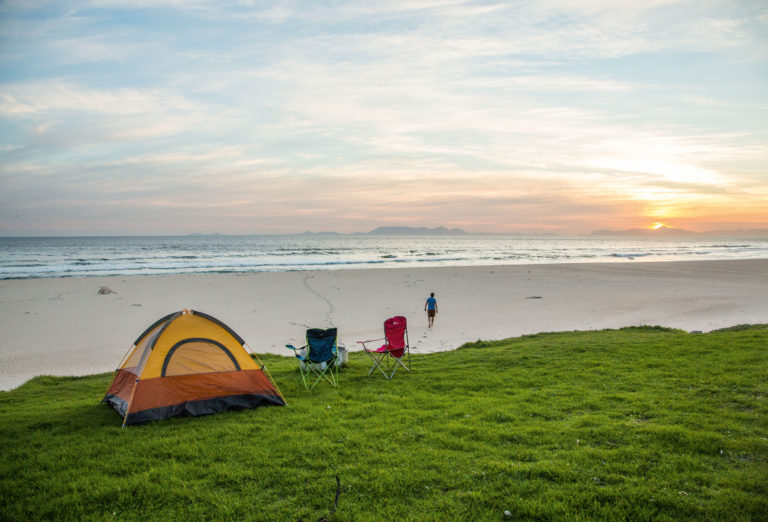
It’s hard to beat the setting of Kogel Bay Resort. In fact, if you were to camp any closer to the sea you’d be sleeping on the sand. Lush grass banks cascade onto a sandy beach overlooking False Bay, with the fynbos-clad Kogelberg forming a natural amphitheatre behind you. During sunset, these mountains take on a golden glow that’s striking enough to interrupt even the most intense beach-bat game.
The resort has a 1.7-kilometre stretch of beach-side campsites, each with a circular cement braai. The sites either have the luxury of soft grass or are surrounded by trees that block the view but also the wind, which can be strong. The facilities are very basic (and sadly, there’s a fair amount of litter in the thickets around the campsite). The soft beach is ideal for a game of touch rugby and the waves are decent too, with the nearby Koeëlbaai a popular surf spot. Beyond surfing, beach activities and two playgrounds in the campsite, there are three hikes in the Steenbras Nature Reserve just across the road. Crystal Pools is the most enticing of these as you traverse a series of pristine rock pools along the Steenbras River. It’s only open in summer, from November to April, and permits need to be arranged beforehand (R65 per group, [email protected]). Watch out for baboons in camp – they’re cheeky and not easily intimidated, so keep food well hidden. A tuck shop runs in high season, but otherwise supplies can be bought in Gordon’s Bay, a 10-minute drive away. – Matthew Sterne
Do It The resort, run by the City of Cape Town, does not take walk-ins and bookings must be done at least 14 days before arrival. There are three tariff seasons, starting from R145 per site to R222 in high season. Up to six people and two cars are allowed per site. Pensioner groups receive a 40 per cent discount during low and mid season. 0218569622 to book, capetown.gov.za
Tip Be safe from the sharks – swim in the tidal pool .
4. Victoria Bay Caravan Park
George, Garden Route

The Outeniqua Choo-Tjoe steam train used to run through Vic Bay, hence the name of one of the camp terraces. In the waves, look out for SA’s top female surfer, Bianca Buitendag, who calls this tiny cove home.
In the shaggy green cliffs overlooking Victoria Bay, three separate camping areas cut long, neat strips into the bluff. These three grassed terraces – Western, Railway and Sea Breeze – sit above the bay’s charming tidal pool and sandy beach, which from Western and Railway terraces can be reached via a few steep stairs. Both have excellent sea views, but Sea Breeze is situated above the busy car park.
During school holidays and especially over Christmas, the bay fills with day-trippers and the beach gets crowded. Out of season, however, it’s sleepy and serene, popular for surfing and angling and an excellent place to chill out and spot whales (from May to October). Railway Terrace has expansive views over the beach, but Western Terrace is the more popular, with stands lying side-by-side along the cliff face, offering a 180-degree panorama that’s especially spectacular at sunrise.
Although the bay feels isolated, both George and Wilderness are just 10 minutes away by car, with the full range of Garden Route activities available nearby including paragliding, nature trails and canoeing along the Touws and Serpentine rivers. George’s Garden Route Mall has camping supplies plus anything else you may need. And if you don’t feel like cooking, there’s Vikki’s at the Beach, which has casual, outside seating below the Western Terrace, and serves sandwiches, pizzas, seafood platters, and beer. – Chris Davies
Do It There are 38 stands in total, 20 on Western, 10 on Railway and eight on Sea Breeze. All those on Western Terrace have private ablutions and washing-up areas, but for stands 30 to 36 they’re a short walk from the sites themselves. Railway and Sea Breeze have neat communal ablutions and sinks, and all 38 have electricity. From R290 a stand at Railway and Sea Breeze, and from R370 at Western Terrace – maximum six per site. No dogs allowed. 0448890081 or 0835308143, victoriabaycaravanpark.co.za
6. Buffalo Bay caravan park
Knysna, Garden Route
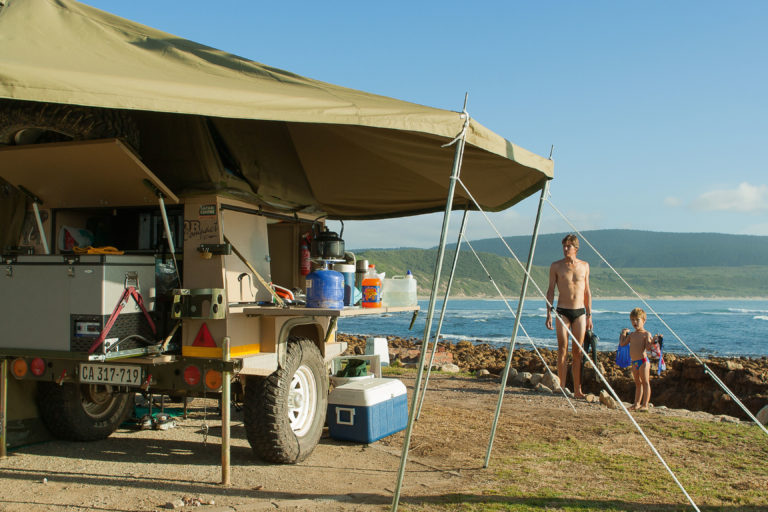
Park the car and hide your keys because everything you need for a family holiday is within walking or cycling distance from your tent.
Buffalo Bay Caravan Park takes the estate-agent maxim of location, location, location to the extreme, with 180-degree sea and beach views from each of the 85 grassed and level sites.
In fact, buffeted by a vicious westerly gale on our first-ever visit, we fell victim to our sea-front perch, two-odd metres above the rock pools. When the squalls cleared the next day, we had to retrieve our kettle, tent pegs and a toddler’s plastic bike from the water. It was a horrible night for tent living, but the view was menacingly spectacular, with writhing swells filling the bay and plumes of spray being whipped backwards like mermaid’s hair.
In kinder weather, the views from Buffels campsite (as it’s colloquially known) are often of surfers sharing the waves with schools of dolphins. A white crescent beach runs for miles from outside the park gate to Brenton on Sea near Knysna. It’s great for walking and at low tide, cycling, too. The water’s warm, the beach (lifeguard-patrolled in season) is good for swimming and surfing, as is the rocky point fronting the park (although there have been some shark incidents in recent years). Safe snorkelling in the rock pools turns up marine life far more interesting than a blackened kettle, and rock and sea angling is a biggie – there’s a slipway adjacent to the park to launch skiboats.
Unfortunately, the nearby Goukamma Nature Reserve is still closed for hiking and canoeing following the Knysna fires. But for horse-riding and canoe hire, go to River Deck Restaurant (riverdeckrestaurant.co.za), overlooking the Goukamma. – Catherine Hofmeyr
Do It All sites have 10-amp electric points and water points close by; ablutions are clean and modern with sculleries and a laundry facility. There’s a supermarket and restaurant within walking distance. Knysna is the closest town (20 kilometres). Rates are from R300 a site for two (R50 for extras) up to R750 in peak season, with extras paying R100. Pensioners pay R200 a site out of season or a monthly rate of R150 a day. 0443830045, buffalobay.co.za
7. Storms River Mouth Rest Camp
Garden Route National Park
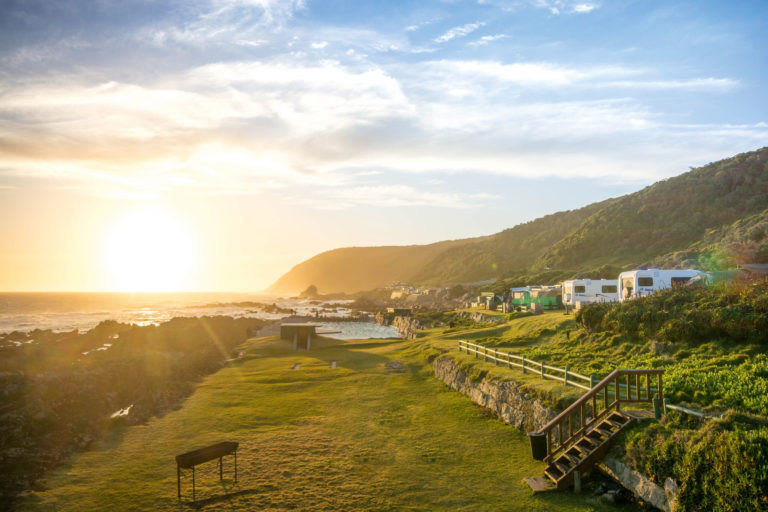
Campers enjoy the best views of all the accommodation options at Storms River.
This camp falls under the Tsitsikamma section of the Garden Route National Park, encompassing the oldest marine-protected area in Africa. Tsitsikamma means ‘place of much water’, which is totally appropriate because some of the campsites are so close to the sea you can feel the spray flicking onto your tent. Accessed via a tarred road, the sites are spread across a grassed area overlooking the Indian Ocean. Facilities include well-kept ablution blocks, a kitchen area, a well-stocked shop and the Cattle Baron Restaurant at the reception.
The swimming pool is a big hit because the shore here is rocky – a wonderland of intertidal and marine life. There is a small sandy beach close to the reception area for swimming. Spend your days between the wild hiking trails, snorkelling the bay with a knowledgeable guide (find stingrays and fish such as grunter and cob) or tackle the Storms River Mouth on a kayak and lilo adventure. – Melanie van Zyl
Do It There are 24 tent sites (plus 77 for caravans). Pack shade protection and lighting as both are lacking, and invest in a sturdy, waterproof tent because the campsite is quite exposed to the wind and elements. Untouched Adventures is based at the rest camp, just below reception, and offers the kayak and lilo adventure: paddling across the bay, then below the suspension bridge and up the narrowing river (from R550 per person). Or there’s guided snorkelling that includes equipment rental (from R440 per person). There are also four nature trails (including one to an ocean-side waterfall) and boat trips on offer. From R169 per person to camp and R59 per person per day for the conservation fees. When booking online, look for campsite codes CK6TV or CK6CPV (which includes a power point). 0422811607, sanparks.org
8. Double Mouth
Morgan Bay, Eastern Cape

A cliff-top trail from Double Mouth to Morgan Bay is excellent for trail running, mountain biking or an hour’s stroll to the village’s main beach.
Not far from the muddy roil of the Great Kei River, you’ll cruise into the laid-back seaside village of Morgan Bay, where most visitors to this idyllic family holiday destination believe they have arrived in paradise. If you continue a further five or so kilometres along the dramatic dolerite sea cliffs to the south-west, you’ll arrive at the Double Mouth Lagoon, and this is, in my books, the country’s most idyllic seaside camping spot. Sets of warm waves crash onto a pristine beach, and you can run or fat-bike for days if you’re keen to explore towards Haga-Haga and beyond. Or reverse direction and head past Morgan Bay to cross the Kei River by pont into the Wild Coast proper.
The campsite at Double Mouth faces a rocky bay but backs onto the lagoon, making it a popular choice for families, as kids can safely splash about in the shallows. Five different biomes overlap here, making for great birding. The fishing is good too, and the area is great for hiking, mountain biking and trail running. On Treasure Beach just beyond the camp, a Portuguese galleon ran aground in the 16th century. Beachcombers may still find Carnelian beads, shards of broken Ming porcelain and money cowries. The subtropical climate means this spot has good weather pretty much all year round. – Jacques Marais
Do It There are 30 level, grassed and shaded sites, each with sea views, a braai facility, tap and power point.
The ablutions are getting on but are functional, with hot water. Off-road caravans are recommended, and the gravel access road gets slippery during rain. Rates from R238 per site to R318, with a limit of six people per site and a daily conservation fee of R11 an adult (R6 for kids). bookonline.ecpta.co.za, 0437054400, visiteasterncape.co.za
9. White Clay
Coffee Bay, Eastern Cape
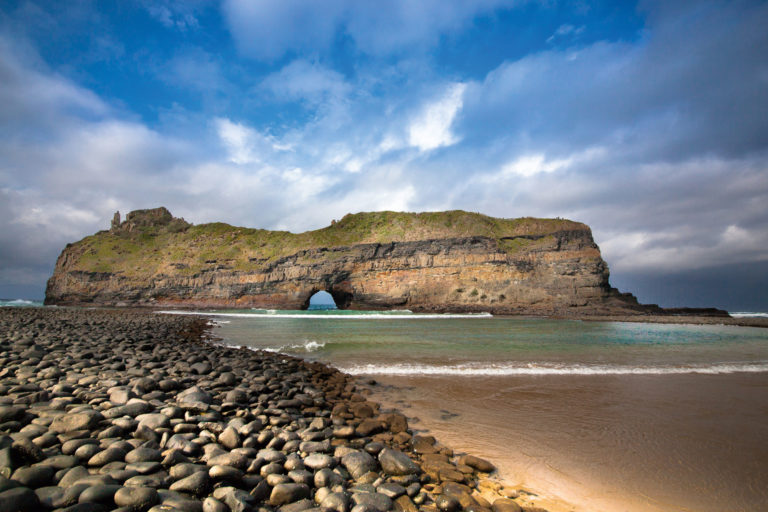
White Clay is well situated between the Wild Coast hot-spots of Coffee Bay and Hole in the Wall, an eight-kilometre hike away.
White Clay is a small, wildly beautiful campsite in the heart of the Wild Coast. It consists of three tiers of level stands on a grassy bank overlooking the sea, with ablutions just a few strides away. All sites have an unimpeded view of the ocean and surrounding cliff-tops – wake up to sunrise over the sea. It’s a short walk down to the beach which is good for fishing and swimming.
This is an ideal spot for active families who enjoy hiking and exploring. We spent our days wandering along the top of the sea cliffs dotted with grazing goats, rondavels and spectacular aloes. For the more adventurous, guided hikes to Port St John’s are also available, and horse-riding and quad-biking can be arranged. The celebrated Hole in the Wall and Coffee Bay are both a short drive away. During the winter months, you just may spot migrating whales and pods of dolphins from the camp.
When you need a break from the braai, there’s a seafood restaurant on site as well as a quaint bar and a curio shop that sells charcoal and wood. – Sarah Changuion
Do It Camping goes from R130 per person up to R170 per person in the December holidays, with no specific limit on the number of people per site. 0832625239, whiteclayresort.co.za
10. Rocky Bay Resort
Scottburgh, Kwazulu-Natal
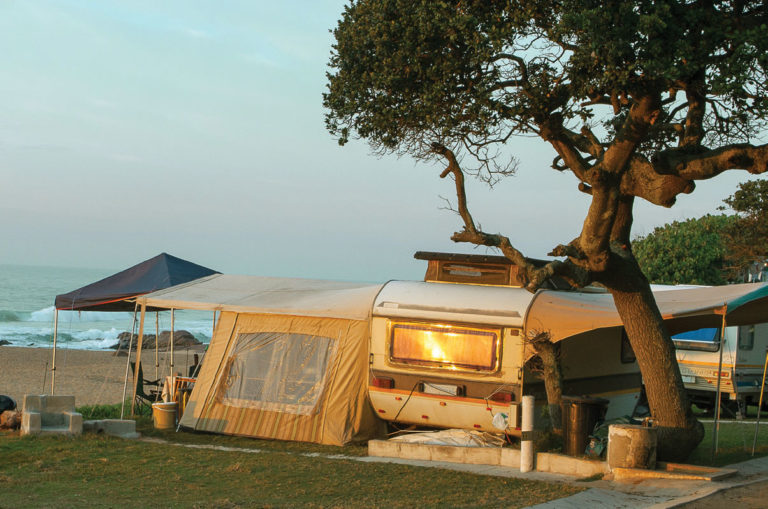
My sister and I spent our pre-teen years swimming on this fabulous stretch of KZN coast while visiting my grandparents, who lived here for 10 years in one of the log cabins. Camping here many years later, I was happy to find that not much has changed at this family resort – even the noisy yellow train still chugged past on its tracks behind the park.
Many semi-permanent caravans are pitched in the best corners (some even have gardens!) and it looks like a delightful way to spend your golden years. A sprawling resort, Rocky Bay has more than 160 campsites, either tucked into indigenous bush or facing the beach, where dolphin sightings are common and, in season, whale sightings too.
Campsites are on level, well-compacted grounds, fringed with lawn. Children flit between jungle gyms and explore the rock pools – thanks to local women who sell buckets, spades and colourful fishing nets at the resort entrance. There are plenty of places to swim, with lifeguards on duty in the main bay, and wonderfully wide, quiet sections of beach further south.
The resort also has a swimming pool, volleyball court, games room with table tennis and pool, and the nearby Sugar Post Restaurant (a homemade pie is just R55 and a burger R60). A decent shop at the entrance stocks all the essentials (like ice cream!).
If you’re after thrills, go shark cage-diving, out in the marine reserve near Aliwal Shoal; the best time is early morning. – Melanie van Zyl
Do It Each stand caters for a maximum of six people, one car and caravan or tent and costs from R215 per person. Pensioners can rent a site at R3,235 for a full month in off-season. Weekend bookings need a minimum two-night stay; December/January bookings require minimum 14 nights. There’s a braai area on each site, but bring your own grid. Dogs (two small ones per site) are allowed out of season and by prior arrangement. Shark dives costs R950 per person, sharkcagedivingkzn.com.
11. Cape Vidal Camp
Isimangaliso Wetland Park, Kwazulu-Natal
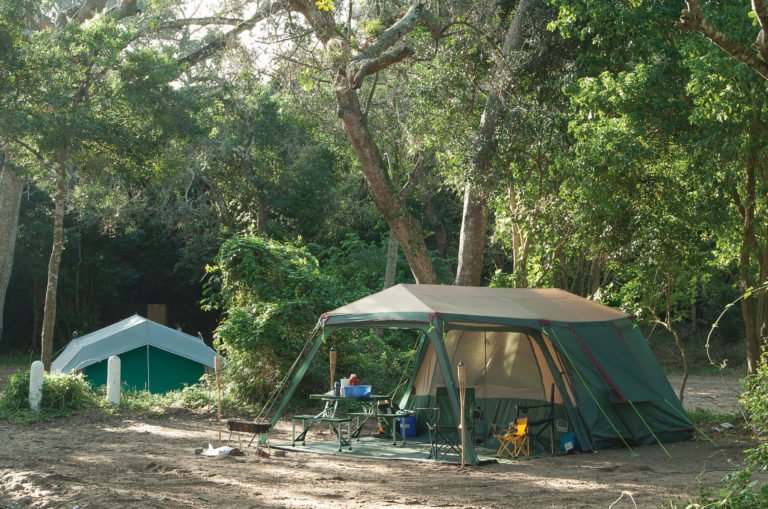
It looks sandy, but you don’t need a 4×4 for the campsites at Cape Vidal as the access road is tarred almost all the way from St Lucia.
Cape Vidal’s campsite is tucked below a forested dune between Lake St Lucia and the Indian Ocean. Shaded from the subtropical sun by a canopy of mahogany and albizia trees, the campsite is a short, sleepy stumble into the warm sea, which is home to dolphins, humpback whales and five turtle species. On its own, it would rank as one of the country’s prettiest settings, but it’s made even more special by its location in iSimangaliso, South Africa’s second-biggest – and most naturally diverse – park.
Booming waves and birdsong are an ever-present soundtrack, with solo performances from howling hyenas and grunting samango monkeys. A broad beach stretches for several kilometres north and south. You can walk for hours without seeing anything man-made. Head out early on a game drive to spot white rhinos, kudus, hippos, and even leopards, which can sometimes be seen on the forest roads. During summer, the beaches are nesting sites for rare leatherback and loggerhead turtles, the largest population on the south-east African coast. Rock pools of oceanic wonders make for great, safe snorkelling at low tide. The marine-protected area permits some fishing, but remember to cast lightly and responsibly – seems wrong, doesn’t it, to kill a beautiful fish in such a pristine place?
Cape Vidal provides an almost perfect beach holiday for the entire extended family. Just watch out for the vervet monkeys, which are always ready to raid your cooler box. And be warned: Cape Vidal’s popularity is also its flaw, and during peak holiday season the campsite can get noisy and congested. Time your visit to the quieter months if possible. – Scott Ramsay
Do It Cape Vidal is 25 kilometres from St Lucia. There are 45 campsites, with communal ablutions (hot showers) which cost from R560 for four people up to R800. Additional people pay from R140 to R200. A nearby shop provides basic supplies. Several accredited companies offer guided nocturnal turtle tours during summer.
0338451000, kznwildlife.com
12. Kosi Bay
Isimangaliso Wetland Park, Kwazulu-Natal

Swimming in the glassy Lake Nhlange is enormously tempting, but keep an eye out for crocs and hippos.
Just south of the Mozambican border on the Indian Ocean coast, Kosi Bay is the country’s largest lake system, with four lakes connected to one another and the ocean by twisting, reed-fringed channels. The campsite is on the western edge of Lake Nhlange, the biggest of the four dark-blue jewels.
Each of the 15 unfenced campsites are secluded from one another by a smattering of coastal forest. At night, stay close to camp, as hippos wander around munching on grass. Fish eagles and rare palm-nut vultures fly over camp, the latter feeding on raffia palms, which grow only in northern KZN.
Home to the Thonga people, Kosi Bay and its surrounds feel more part of Mozambique than South Africa. The curvaceous Thongan fishing traps harmonise perfectly with the lake’s surface and are a feature of the area. The designs of the traps date back more than 500 years and are still used today to catch a variety of estuarine fish (though catches have declined in recent years due to overfishing). Keep in mind that you must always ask permission when taking photos of the local fishermen.
Boat tours at Lake Nhlange to Lake Makhawulani are a must-do, and a variety of companies offer this service. Set aside a day to drive to the estuary in the north, to snorkel in the shallows and spot the likes of Moorish idols, but don’t get too close to the lionfish with their venomous spines. The odd moray eel also lurks in the shallow corals.
The beaches at Kosi Bay on the shoreline are, like Cape Vidal, also nesting sites of leatherback and loggerhead turtles. As you would in any game reserve with dangerous wildlife, keep an eye on your youngsters. – Scott Ramsay
Do It Kosi Bay is in the remote northern part of iSimangaliso Wetland Park and the sand tracks require a 4×4 or vehicle with high clearance. During school holidays it can get booked out, so visit during off-season. Each campsite has a braai place, cold- water tap and electricity point, and they range in price from R460 for four people to R660. Additional folks pay from R115. Two ablution blocks have hot-and-cold-water showers and toilets. 0338451000, kznwildlife.com
You may also like
Related Posts
The Northern Cape landscape and its characters are full of life. Here are some of...
read more
If you're feeling a bit tired of the usual scene, take a tip from urban...
read more
The east coast is our very own tropical paradise with warm waters and laid-back vibes....
read more